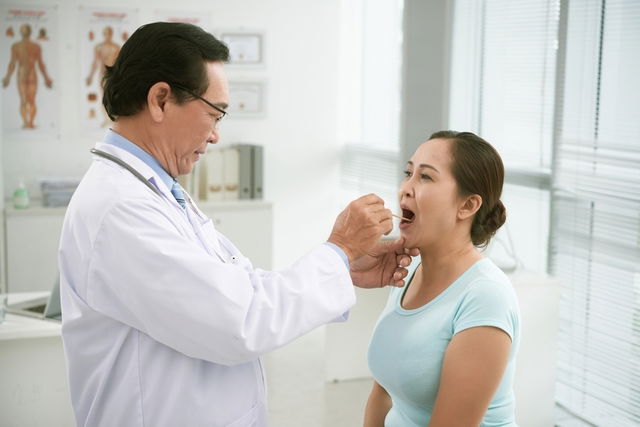Gum pain can be caused by inflammation of the gums, called gingivitis, poor oral hygiene, use of braces and dental prosthetics, mouth ulcers, hormonal changes, infection or it can be a sign of rupturing wisdom teeth.
In some cases, in addition to gum pain, you may notice bleeding, especially when brushing your teeth, as well as bad breath. It is important to have these symptoms assessed by a dentist.
Treatment for gum pain typically depends on the underlying cause of pain, which may be need to be diagnosed by a dentist. The dentist may prescribe specific treatment and measures that help relieve pain and discomfort, such as good oral hygiene, appropriate nutrition or the use of an antiseptic and healing syrup.

What causes gum pain?
The main causes of gum pain are:
1. Poor oral hygiene
Poor oral hygiene habits, such as lack of brushing or brushing too hard, can cause gum bleeding, inflammation and infection, which can lead to gum pain.
What to do: It is essential to maintain good oral hygiene by brushing your teeth at least twice a day, especially after meals, and using dental floss and mouthwash. Furthermore, it is also important to brush your teeth without using too much force, preferably using a soft brush, to prevent gum damage.
2. Gingivitis
Gingivitis is characterized by gum inflammation due to the accumulation of bacterial plaque on the teeth. It causes gum pain between the teeth, bleeding, swelling and redness. Gingivitis usually happens due to poor oral hygiene, but it can also be due to other factors such as cracked or broken teeth, changes in hormones, cancer, alcohol, stress, poor diet, or insufficient saliva production.
What to do: It is important that to consult a dentist as soon as you notice symptoms of gingivitis so that treatment can be started immediately. Adequate measures can prevent the development of periodontitis. Typically, gingivitis is treated by performing a complete dental cleaning, although in some cases, antibiotics may be prescribed.
Read about home remedies you can use to complement your dentist's treatment to help you get rid of gingivitis faster.
3. Use of braces and dentures
Braces and dentures can also cause gum pain, as the use of this equipment can lead to a greater risk for he accumulation of food debris and microorganisms. These can lead infection and, consequently, pain, swelling and bleeding in the gums. Furthermore, if these devices are poorly fitted, they can cause swelling, inflammation and pain in the jaw or teeth.
What to do: In these cases, it is especially important to maintain adequate oral hygiene to avoid the accumulation of food debris. It is also important to report ill-fitting dentures or braces to your dentist. You should follow-up with your dentist regularly for maintenance and reassessment.
4. Canker sores
Canker sores are small, painful lesions that usually appear on the tongue and lips, but can also affect the gums. They are associated with pain and discomfort in the area. Canker sores can be caused by mouth injuries, acidic or spicy foods, vitamin deficiencies, hormonal changes, stress or autoimmune disorders. Learn more about the causes of canker sores and how they are managed.
What to do: To alleviate the discomfort caused by canker sores, you can use a gel with anti-inflammatory properties or a healing and antiseptic mouthwash. These can help to eliminate the canker sore within 2 weeks. Canker sores that do not resolve within this time frame, or canker sores that are recurrent should be assessed by a dentist for assessment and treatment.
5. Wisdom tooth rupture
The growth of wisdom teeth, which usually happens between the ages of 17 and 21, can also cause pain and immense discomfort in the gums at the back of the mouth.
What to do: To relieve wisdom tooth pain, you can apply a gel with benzocaine to the area, or rinse your mouth with an anti-inflammatory mouthwash. In cases the wisdom tooth is impacted (ie. not growing upwards), the doctor may consider removal.
6. Oral thrush
Thrush, also called oral candidiasis, is an infectious disease caused by the Candida albicans fungus that affects the mouth and leaves a white coating on the tongue and cheeks. It is also associated with gum pain.
What to do: It is important to consult your dentist or family doctor to confirm a that diagnosis so that treatment can be started. Treatment usually consists of an antifungal oral rinse, such as Nystatin or Miconazole, to be gargled and spit out.
7. Gum abscess
A gum abscess is a pocket of tissue inflamed with pus that appears due to infection at the root of the tooth. It is associated with intense pain and swelling in the gums.
What to do: If you have signs and symptoms of a tooth abscess, you should consult a dentist immediately for assessment and abscess removal. The dentist may also recommend the use of antibiotics and anti-inflammatories.
8. Hormonal changes
Hormonal fluctuations are common in women, and can happen due to several occurrences like puberty, during the menstrual cycle, during pregnancy and menopause. All of these phases can affect the gums.
During puberty and pregnancy, blood flow increases to the gums, making them more swollen, sensitive or painful. During menopause, hormone levels decrease, which can cause bleeding and pain in the gums, as well as changes to color.
What to do: You should consult a gynecologist to assess hormonal levels as well as any other possible symptoms. A complete and thorough assessment will help to guide treatment.
